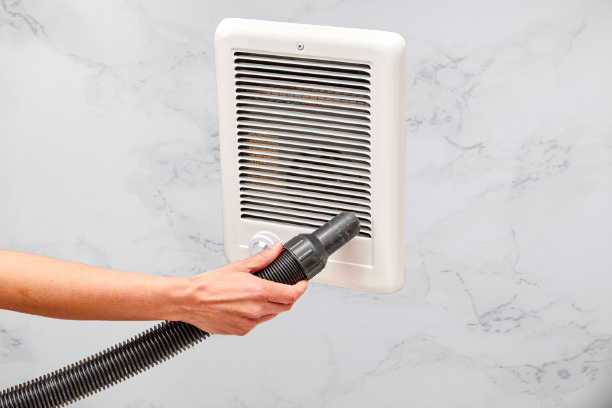How To Clean Wall Heaters

Our cleaning experts show you how to clean electric wall heaters, a crucial task for its proper maintenance. It’s best to clean your electric heater at least twice a year. However, if you have pets or live in an area with lots of dust and dirt, consider cleaning it more often. Dust and pet hair can accumulate in your heater, making it less efficient and, in extreme cases, causing damage to the unit.
In this article, we will uncover the tips to clean wall heaters.
Introduction to Cleaning Wall Heaters
Wall heaters, also known as electric wall heaters (1) or convection heaters, are excellent for heating specific areas in your home. They are energy-efficient, compact, and easy to install.
However, to fully enjoy their benefits, you must know how to clean and maintain them properly. Dirty or malfunctioning wall heaters can be not only inefficient but also hazardous.
In this comprehensive guide, we’ll provide a step-by-step process for cleaning your wall heaters, discuss essential safety precautions, and answer frequently asked questions about maintaining these devices.
By the end of this article, you’ll be well-equipped to ensure your wall heaters keep your home warm and safe.
Tools Required to Clean Wall Heaters
Before starting the cleaning process, gather the necessary tools and materials. You’ll need a screwdriver, a vacuum cleaner, a microfiber cloth, and a can of compressed air.
PRO TIP: Make sure to unplug the wall heater before you begin.
| Dust mask |
| Safety glasses |
| Drop cloth |
| Voltage detector |
| Small container |
| Phillips and flathead screw drivers |
| Bucket filled with soapy water and wash cloth |
| Air compressor or vacuum with blower option |
How to Clean Wall Heaters – Easy Steps
1. Switch Off the Heater Circuit
Before you begin any maintenance, ensure the circuit powering your heater is switched off. Use a voltage detector to confirm complete power shutdown for safety.
2. Removing the Grill
Start the cleaning process by carefully removing the grill. If your heater has a thermostat, be extra cautious when removing the knob to avoid potential damage.
3. Clear Dust from the Heater
Use an air compressor, vacuum with a blower, or even a hair dryer (avoid canned air) to blow dust out of the heater. Ensure the fan blades don’t spin to avoid motor damage.
4. Give the Grill a Good Clean
After removing the grill, soak it in soapy water to clean it thoroughly while you’re dusting the heater.
5. Reattach the Grill Securely
Once the grill is dry, securely reattach it. Be cautious not to over-tighten the screws, as this may damage the grill.
6. Turn the Heater Back On
After cleaning:
- Switch the circuit breaker back on.
- Increase the thermostat setting to start the heater and run it for a few minutes.
- Ensure it warms up correctly and operates smoothly, then adjust it to your desired temperature.
Following these steps will help maintain your heater, ensuring it continues to provide warmth when needed.
PRO TIP: Remember that safety should be your top priority, and if you’re unsure about the best course of action, consulting the manufacturer or a professional technician is always a good idea.
Can I Clean Electric Wall Heaters With Soap and Water?
It’s not advisable to clean the blades with moist soap and water, especially after using an air duster.
Electric wall heaters have sensitive electrical components, and introducing moisture can lead to electrical issues or even corrosion, which may result in reduced efficiency and more noise.
The canned air you used should have removed most of the dust from the blades, which is the primary concern.
How to Reduce Noise From My Wall Heater
The noise you’re hearing could be due to various factors, one of which might be the fan bearings wearing out. After six years of use, this is a possibility.
Cleaning alone may not solve this issue, and you might want to consider inspecting and potentially replacing the fan if it’s the source of the noise.
Frequently Asked Questions (FAQs) – Cleaning Electric Wall Heaters
1. How often should I clean my electric wall heater?
- It’s best to clean your electric wall heater at least twice a year. However, if you have pets or live in an area with lots of dust and dirt, consider cleaning it more often. Dust and pet hair can accumulate in your heater, making it less efficient and, in extreme cases, causing damage to the unit.
2. Can I clean electric wall heaters with soap and water?
- It’s not advisable to clean the blades with moist soap and water, especially after using an air duster. Electric wall heaters have sensitive electrical components, and introducing moisture can lead to electrical issues or even corrosion, which may result in reduced efficiency and more noise.
3. How can I reduce noise from my wall heater?
- The noise you’re hearing could be due to various factors, one of which might be the fan bearings wearing out. After six years of use, this is a possibility. Cleaning alone may not solve this issue, and you might want to consider inspecting and potentially replacing the fan if it’s the source of the noise.
4. Do wall heaters need to be cleaned?
- Yes, wall heaters should be cleaned regularly. Dust and dirt can collect in them, causing them to work less effectively and safely. It’s a good idea to clean them or have a professional service them to keep them in good working condition.
Conclusion
Regular cleaning of your electric wall heater is essential for its proper maintenance. It’s recommended to clean it at least twice a year, but if you have pets or live in a dusty environment, consider cleaning it more frequently to prevent decreased efficiency and potential damage. By following the steps outlined in this guide, you can ensure your wall heater operates efficiently and safely, keeping your home warm and comfortable.
I hope after reading our article you know how to clean wall heaters.
How to Clean Wall Heater – Video Tutorial
Refrence:
- https://www.thespruce.com/electric-wall-heater-info-1821922






